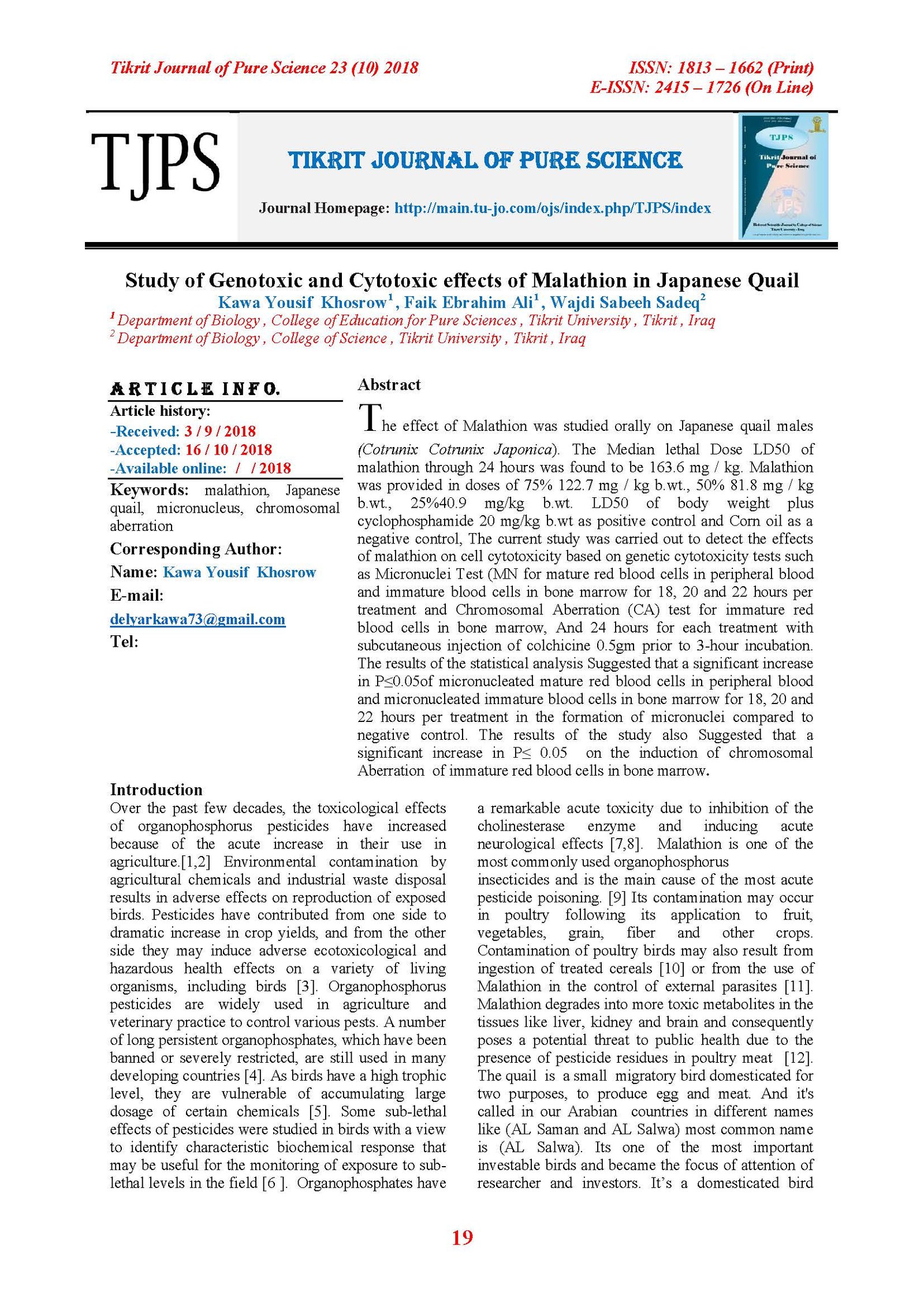Study of Genotoxic and Cytotoxic effects of Malathion in Japanese Quail
Main Article Content
Abstract
The effect of Malathion was studied orally on Japanese quail males (Cotrunix Cotrunix Japonica). The Median lethal Dose LD50 of malathion through 24 hours was found to be 163.6 mg / kg. Malathion was provided in doses of 75% 122.7 mg / kg b.wt., 50% 81.8 mg / kg b.wt., 25%40.9 mg/kg b.wt. LD50 of body weight plus cyclophosphamide 20 mg/kg b.wt as positive control and Corn oil as a negative control, The current study was carried out to detect the effects of malathion on cell cytotoxicity based on genetic cytotoxicity tests such as Micronuclei Test (MN for mature red blood cells in peripheral blood and immature blood cells in bone marrow for 18, 20 and 22 hours per treatment and Chromosomal Aberration (CA) test for immature red blood cells in bone marrow, And 24 hours for each treatment with subcutaneous injection of colchicine 0.5gm prior to 3-hour incubation. The results of the statistical analysis Suggested that a significant increase in P≤0.05of micronucleated mature red blood cells in peripheral blood and micronucleated immature blood cells in bone marrow for 18, 20 and 22 hours per treatment in the formation of micronuclei compared to negative control. The results of the study also Suggested that a significant increase in P≤ 0.05 on the induction of chromosomal Aberration of immature red blood cells in bone marrow.
Article Details

This work is licensed under a Creative Commons Attribution 4.0 International License.
Tikrit Journal of Pure Science is licensed under the Creative Commons Attribution 4.0 International License, which allows users to copy, create extracts, abstracts, and new works from the article, alter and revise the article, and make commercial use of the article (including reuse and/or resale of the article by commercial entities), provided the user gives appropriate credit (with a link to the formal publication through the relevant DOI), provides a link to the license, indicates if changes were made, and the licensor is not represented as endorsing the use made of the work. The authors hold the copyright for their published work on the Tikrit J. Pure Sci. website, while Tikrit J. Pure Sci. is responsible for appreciate citation of their work, which is released under CC-BY-4.0, enabling the unrestricted use, distribution, and reproduction of an article in any medium, provided that the original work is properly cited.
References
[1] Shanaway, M.M.(1994). Quail production systems. Areview. Food and Agriculture Organization of the United Nations, First Edition. Roma, Italy. 169-170.
[2] Hill, E. F. and Camardese, M. B.. (1986). Lethal dietary toxicities of environmental contaminants and pesticides to coturnix. U.S. Fish Wild. Serv., Tech. Rep. 2. 147 pp.
[3] Blasiak, J. J and Treciak, A.S. (1999). In vitro studies on the genotoxicity of the organophosphorus insecticide malathion and its two analogues. Mutat Res.; 445:275-83.
[4] De Silva, H.J.; Samarawiskrema, N.A. and Wickremasingle, A.R. (2006). Toxicity due to organophosphorus compound: What about chronic exposure? Trans. R.soc. Trop. Med. Hyg., 100(9): 803-806.
[5] Deka, K. and Borah, J. (2008): Haematological and Biochemical Changes in Japanese Quails Coturnix coturnix Japonica and Chickens Due to Ascaridia galli Infection. International Journal of Poultry Science, 7 (7): 704-710.
[6] Dahamna, S. Sekfali, N. and Walker, C.H. (2004). Biochemical indicators of hepatotoxic effects of pesticides. Commun. Agric. Appl. Biol. Sci., 69(4): 821-828.
[7] Pope, C.N. (1999). Organophosphorus pesticides: Do they all have the same mechanism of toxicity? J Toxicol Environ Health B 2, 161–181.
[8] Varsik, P.B. et al. (2005). Chronic Poisoning neuropathy after organophosphorus poisoning in quails (Coturnix coturnix japonica). Bartisl Lek Listy, 106 (10): 293-296.
[9] Pant, R. and Katiyar, S.K. (1983). Effect of malathion and acetylcholine on the developing larvae of Philosamiaricini (Lepidoptera: Saturniidae). J. Biosci. 5:89-95.
[10] Moghadamina A.A. and Abdollahi, M. (2002). An epidemiological study of poisoning in Northern Ialamic Republic of Iran. East Meditter. Health, J., 8:1-6.
[11] Rao, D.D. and Yadgirkar, G. (2000). Pathology of subacute malathion toxicity in Japanese quail. Ind. J. Vet. Pathol., 24: 39-40
[12] Garg, U.K. Pal, A.K. Jha, G.J. and Jadhao, S.B. (2004): Hemato - biochemical and immunepathological effects of chronic toxicity with synthetic pyrethroid, organophosphate and chlorinated pesticides in broiler chicks. International Immunopharmacol., 4:1709-1710.
[13] AL-Husni, M. A. (2003). Quail production, First Edition , Ibn Sina Press, Cairo. pp :5 -8.
[14] Extenstion Toxicology Network. (1996). "Pesticide Information Profile- Malathion." Accessed 05-17-11.
[15] Dixon, W.J.(1965). The Up- and- Down Method for Small Samples. Journal of the American Statistical Association Vol. 60, No. 312 (Dec., 1965) , pp . 967 – 978 .
[16] Edenharder, R.. F.et al.(1998). Protective effects of fruits and vegetables against in viva clastogenicity of cyclophosphamide or benzo(a) pyrene in mice. Food and Chemical Toxicol., 36, pp.637-645. 9.
[17] Paget, G.E. and Barnes, J . M. (1964). Toxicity tests In evaluation of drug activities: pharmocomettrics Academic Press, London, pp:140-161.
[18] Schmid, W. (1976). The Cell Micronucleus Test for Cytogenesis analysis. In: Chemical Mutagens Principles and Methods for their Detection. Vol. 4. Hollaender, A. (Ed.). Plenum Press, New York & London. pp: 31-53.
[19] Abramsson, Z.L.(1997). Chromosome aberration detectied by the flow cytometer based micronucleus assay . Acta Univ.Ups.278 pp:109-113.
[20] Ni, Z.S. et al. (1993). Induction of micronucleus by organophosphorus pesticides both in vivo and in vitro. Hua Xi Yi Ke Da Xue Xue Bao (Chineses).24: 82-86 .
[21] Yoshida, T.H. and Amano, K.(1965). Autosomal Polymorphism in Laboratory Bred and wild Norway rats, Rattus norvegicus. Misima Chromosoma,16: 658-667.
[22] Walum, E. (1998). Acute Oral Toxicity. Enveronmental Health Perspectives. Vol.106 Supplement 2.
